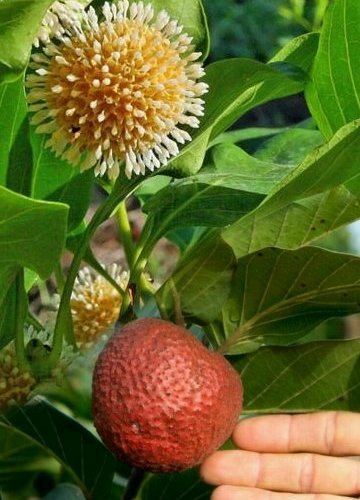
|
|
African peach
(Nauclea latifolia). Flowers and fruits.
|
African peach - Nauclea latifolia
African peach (Nauclea latifolia) is
a plant in the family Rubiaceae. It is a
deciduous flowering shrub
or tree with an open canopy, usually branching from low down the bole. It varies
widely in height from around 10 metres up to 30 metres according to soil and
moisture conditions.
The edible fruit is gathered from the wild for local use. Much appreciated by
the local populace, it is often sold in local markets.
The generic name (Nauclea) is derived from the Ancient Greek words naus, meaning "ship" and kleio, meaning "to close". It refers to the resemblance of the cells of the capsule to a ship's hull.
Nauclea latifolia Sm. is now known to be a synonym of Sarcocephalus latifolius (Sm.) E.A.Bruce
The bark is dark gray, fibrous, and cracked. It has small branches that are thick and
drooping, with large, simple, conspicuously veined leaves and strange but beautiful, globose, strongly fragrant, white inflorescences followed by curiously pitted, red, edible fruits with juicy, sweet, red, apple-flavored pulp. Nauclea latifolia is native to tropical Africa, where it grows in lowland savanna woodland. It adapts well to cultivation in tropical climates and starts producing fruits after only a few years. It is, however, essentially unknown in cultivation outside of Africa.
The fruit is edible. It is a compound fruit, red or pinkish, and round consisting of very small seeds. Its pulp is deep red, watery, and has a sweet
flavor of ripe apple. The fruit is said to resemble a strawberry in taste and texture. The globose fruit is about 8cm in
diameter
Flower heads are cooked and eaten as a vegetable.
African Peach is used against various medical conditions such as diabetes, fever, indigestion, and cough.
The root is febrifuge and tonic. It is used in the treatment of fevers, indigestion.The fruit is eaten as a cure for coughs.
The bark and roots of the plant contain more than 1% of an opioid that is clinically identical to the analgesic drug 'tramadol'. It can be extracted in a cost-effective way to provide an economical source of this widely used analgesic.
Extracts of the plant have exhibited activity against Escherichia coli, Shigella flexneri, Salmonella typhi and Staphylococcus aureus (which are responsible for gastroenteritis in children).
The alkaloid strictosamine is obtained from the roots, leaves and stem bark.
Agroforestry Uses: A suitable species for planting schemes for conservation and soil stabilization. The tree offers shade and acts as a windbreak. It is used as a live stake to provide barriers in farms. The leaves are used as a mulch.
Small twigs are used as chewing sticks. The bark is a source of tannins. A yellow dye is obtained from the roots. The heartwood is dark red-brown, hard and moderately heavy. The wood is resistant to termites. It is used for inlay work. The wood is used for fuel.
Source:
https://en.wikipedia.org/wiki/Nauclea
https://pfaf.org/user/Plant.aspx?LatinName=Nauclea+latifolia
https://www.rarepalmseeds.com/nauclea-latifolia?search=Nauclea
